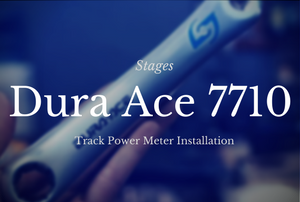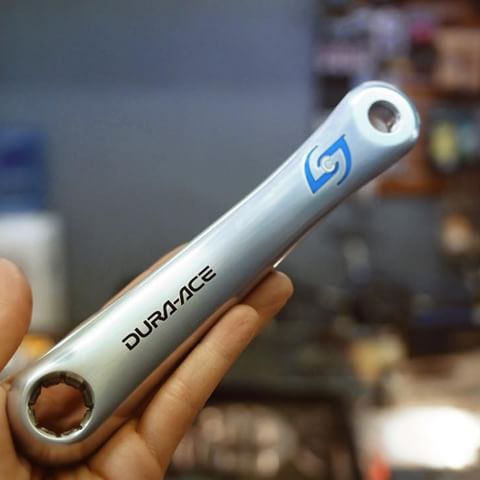Power meter options for track bikes are very limited, and the Dura Ace Stages power meter is one of the most reasonably priced and simple to use on the market. Based on the Dura Ace 7710 Octalink platform, the Stages power meter offers a simple, elegant power measuring solution for fixed gear bikes. Painstaking refinement has gone into the algorithm used to calculate power to meet the unique demands of a fixed gear bike, improving performance and reliability in data recording.
Check out the video of the installation, re-posted from Periscope. Throughout the installation, there's a little bit of Q&A about power meters based on questions from live viewers. Click through the jump to watch the video and check out the video show notes:
If you're in the market for a power meter, I recommend Stages and they're huge supporters of the Tailwind Cocaching Podcast, so check them out. Like all Stages Power Meters, the Dura Ace 7710 track model is sold as a left crank arm with an electronics pod mounted to it. The same CR2032 battery that powers every Stages power meter supplies the power for this unit as well, making it user-friendly and easy to replace.
If you want to pick up any of the tools I use in this video, check them out here.
Stages Power Meter Install Q&A:
Q: What is a power meter and how does it work?
A power meter is a tool that measures the amount of effort that's going into your pedals.
Pretty simply, a power meter is a device that contains a series of strain gauges and measures the force put through the crank arm. In the case of a Stages power meter, there's a pod mounted to the back of the left crank arm. That pod contains strain gauges, which change electrical properties based on the deformation of the crank arm when it's put under load (your pedaling.) That change in electrical properties can be interpreted, through an algorithm, as the amount of force needed to deform the crank arm. Combine it with an accelerometer based cadence measurement and you can calculate power.
Q: What is power?
Power is a combination of pedal force and pedaling cadence. It is an absolute measure of effort, expressed in watts. Power is a useful metric to track because it is independent of daily physiological variability. Heart rate is a much cheaper option (more on that below) to start tracking, but it can vary based on physiological status each day. Power itself is a measure of output (how much force goes into the pedals) vs a measure of input (how hard my body is working to put that force to the pedals.)
For example, if I'm putting out 200 Watts of power, I'm putting out 200 Watts of power. Today I may be doing that 200 W at a heart rate of 150 Beats Per Minute. Tomorrow I may drink 4 cups of coffee before I ride, sleep poorly the night before and be stressed out, and I'll put out 200 W of power at 170BPM.
The output doesn't change, but how hard the body works to make that output happen changes quite a bit. That's what makes a power meter a great training tool: you have absolute data to work with.
Q: How much does a power meter cost?
Power meters can vary greatly in price. A Stages Power Meter such as the Dura Ace 7710 that I install in the video runs about $650 USD. Some other examples, such as SRMs run around $2500 USD. Each kind of power meter has its own advantages and disadvantages, and you can read about each one of them in my “Choosing A Power Meter” post/podcast.
Want to get MORE tips and tricks on build a bike and build fitness? Subscribe to the Tailwind Coaching Newsletter to get my best coaching tips delivered to your inbox, along with a free bonus training plan.
If you're looking for a complete training solution, you can pick up your training plans by checking out my modular training plans in my online store. Summer goals will be here before you know it, so you'll need to start building fitness and thinking about climbing, sprinting or preparing for a century ride. Let me help you out by providing your training path to glory!

